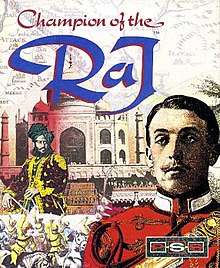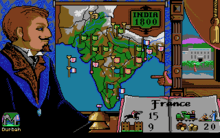Champion of the Raj
Champion of the Raj is a turn-based strategy video game developed by Level 9 Computing and published by Personal Software Services. It was released exclusively in the United Kingdom for the Amiga, Atari ST and systems running DOS in 1991. It is the thirteenth and final instalment to the Strategic Wargames series. The game revolves around European imperialism and colonialism of India, in which six factions: British, French, Mogul, Sikhs, Gurkhas and Marathas fight to gain overall control of India.
| Champion of the Raj | |
|---|---|
 Atari ST cover art | |
| Developer(s) | Level 9 Computing |
| Publisher(s) | Personal Software Services |
| Series | Strategic Wargames |
| Platform(s) | Amiga, Atari ST, DOS |
| Release |
|
| Genre(s) | Turn-based strategy |
| Mode(s) | Single-player |
The game contains elements of combat and arcade sequences, including traditional elephant racing and big-game hunting. The core of the gameplay is focused on strategy, in which the player must conquer all territories of India through diplomatic or offensive means. Champion of the Raj received mixed reviews upon release. Critics praised its colourful graphics and storyline; however strong criticism was directed at the game's constant use of disk swapping and long loading times.
Gameplay

The game is a turn-based strategy and revolves around colonialism of India. Before starting the game, the player must pick a player-character and the respective faction they wish to side with. The choices include a viceroy of the British East India Company, a consul of the French East India Company, a Mogul emperor, a Maharajah of the Maruthras, chief of the Gurkhas or a Maharajah of the Sikhs.[1] At the beginning of the game, the player-character is kidnapped by an assassin and is imprisoned inside a prison cell. A woman soon frees the player-character, and informs them of their task to either conquer India or persuade rival political factions to unite through diplomacy.[1] The game begins in 1800, when the Mogul empire lost control of India. The majority of the game is presented through an in-game headquarters screen which displays a map of India, a book detailing information of individual Indian states, and a group of icons which allows the player to issue commands.[1]
If the player wishes to take over a territory through diplomatic means, they must initiate dialogue with the local leader. If the player has a high enough popularity, the local leader may invite them to a sporting event, such as elephant race or a game hunting session, which will give the player an opportunity to unite that territory under their faction.[1] If the player's popularity is not high enough, they may hold a Durbar festival in an attempt to impress the local leaders. If diplomacy fails, the player has the option to invade any territory by force.[2] Soldiers can be hired through payments of gold; however, if the player does not have a sufficient amount of gold at the end of the turn, a rebellion may start.[2] Rebellions will sometimes initiate lethal encounters with assassins, in which the player-character must defend themselves through sword combat. Additionally, the player can bring assassins to their side by successfully launching an attack on their temple.[1] The game will end once either all of the territories are united, or if the player-character is assassinated.[3]
Background
Personal Software Services was founded in Coventry, England, by Gary Mays and Richard Cockayne in November 1981.[4] The company was known for creating games that revolved around historic war battles and conflicts, such as Theatre Europe, Bismarck and Falklands '82. The company had a partnership with French video game developer ERE Informatique and published localised versions of their products to the United Kingdom.[5] The Strategic Wargames series was conceptualised by software designer Alan Steel in 1984. During development of these titles, Steel would often research the topic of the upcoming game and pass on the findings to other associates in Coventry and London.[4][6] In 1983, the company received recognition for being "one of the top software houses" in the United Kingdom, and was a finalist for BBC Radio 4's New Business Enterprise Award for that year.[6][7]
In 1986, Cockayne took a decision to alter their products for release on 16-bit consoles, as he found that smaller 8-bit consoles, such as the ZX Spectrum, lacked the processing power for larger strategy games. The decision was falsely interpreted as "pulling out" from the Spectrum market by video game journalist Phillipa Irving.[8] Following years of successful sales throughout the mid 1980s, Personal Software Services experienced financial difficulties, in what Cockayne admitted in a retrospective interview that "he took his eye off the ball". The company was acquired by Mirrorsoft in February 1987,[9] and was later dispossessed by the company due to strains of debt.[10]
Reception
| Reception | ||||||||||||||
|---|---|---|---|---|---|---|---|---|---|---|---|---|---|---|
| ||||||||||||||
The game received mixed reviews upon release. Gordon Houghton of The One for ST Games disliked the arcade sequences in the game, stating that they are "a waste of disk loading time", despite acknowledging its way of giving the strategy genre a wider appeal.[1] Ed Ricketts of ST Format stated that despite its simplicity, the game was "enjoyable" to play.[2] Fiona Keating of CU Amiga praised the game's entertaining storyline and colourful graphics, but criticised its sound, labeling it a "shortcoming".[3] Jonathan Davies of Amiga Power criticised the simplicity of the gameplay, stating that despite the "impressive" graphics, the game "was not meant for a few minutes of playtime".[11] Gary White of Advanced Computer Entertainment heavily criticised the visuals, stating that it had an "appalling" presentation and poor sound quality.[12]
The disk loading time was the most criticised aspect from reviewers. Houghton found the loading times "hefty" and recommended that the player use two disk drives instead of one, as constant disk swapping was required in the game.[1] Ricketts similarly found the swapping of "half a dozen" floppy disks a "nightmare" on the Atari ST.[2] Keating found the "huge" amount of disk swapping to be the game's largest drawback, as well as the long loading times that accompanied it.[3] Davies stated that scrolling times were "painfully slow" due to the excessive disk accessing.[11] White stated that the game had a disk access routine "so bad" that it was almost impossible to access icons during gameplay, as the cursor movement was always a second behind actual mouse movements.[12]
References
- Houghton, Gordon (July 1991). "Champion of the Raj review". The One for ST Games (34): 66, 67. Retrieved 21 February 2016.
- Ricketts, Ed (August 1991). "Champion of the Raj review". ST Format (25): 62. Retrieved 21 February 2016.
- Keating, Fiona (July 1991). "Champion of The Raj review (CU)". CU Amiga (17): 102, 103. Retrieved 21 February 2016.
- "History of PSS". Your Computer. 6 (6): 84–85. 13 June 1986. Retrieved 3 October 2015.
- "Personal Software Services overview". Retro Aisle. Retrieved 18 October 2015.
- Connor, Peter (March 1986). "Special: PSS". Amstrad Action (6): 97–99. Retrieved 5 February 2016.
- "PSS: Blade Alley Competition". Crash (5): 28. June 1984. Retrieved 5 February 2016.
- Jarratt, Steve (May 1988). "Seasonal Drought". Crash (52): 7. Retrieved 18 October 2015.
- "Mirrorsoft has new strategy with PSS". Personal Computing Weekly. 6 (7): 6. 12 February 1987. Retrieved 18 October 2015.
- Arnot, Chris (26 March 1995). "Taking pain out of gain". The Independent. Archived from the original on 5 March 2016. Retrieved 4 October 2015.
- Davies, Jonathan (August 1991). "Champion of The Raj review (AP)". Amiga Power (4): 74. Retrieved 21 February 2016.
- White, Gary (August 1991). "Champion of the Raj review (ACE)". Advanced Computer Entertainment (47): 82. Retrieved 21 February 2016.